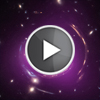CXC Home | Search | Help | Image Use Policy | Latest Images | Privacy | Accessibility | Glossary | Q&A
Tour of SDSS J103842.59+484917.7
Quicktime MPEG With closed-captions (at YouTube)
One hundred years ago this month, Albert Einstein published his theory of general relativity, one of the most important scientific achievements in the last century. A key result of Einstein's theory is that matter warps space-time. This means that a massive object can bend the light we see on Earth from very distant objects, say, faraway galaxies. Astronomers have found many examples of this phenomenon, known as "gravitational lensing." Gravitational lensing is more than just a cosmic illusion, however. Instead, gravitational lensing provides astronomers with a way of probing extremely distant galaxies and groups of galaxies in ways that would otherwise be impossible even with the most powerful telescopes.
The latest results from the "Cheshire Cat" group of galaxies show how manifestations of Einstein's 100-year-old theory can lead to new discoveries today. Astronomers have given the group this name because to many it looks like a smiling cat from the famous story of "Alice in Wonderland." In a twist that perhaps Lewis Carroll could appreciate, some of the feline features in this cosmic Cheshire Cat are actually distant galaxies whose light has been stretched and bent by the large amounts of mass in the system.
Astronomers have studied the Cheshire Cat in optical light from telescopes like the Hubble Space Telescope and the Gemini Observatory on Mauna Kea. They have also used the Chandra X-ray Observatory to study it in higher-energy light. X-rays from Chandra reveal gas in between the galaxies that has been heated to millions of degrees. This superhot gas is evidence that the two eyes of the Cheshire Cat, and the small galaxies associated with them, are racing toward one another at very high speeds. In fact, astronomers estimate that these galaxies will merge in about one billion years. X-ray data also show that the left "eye" of the Cheshire Cat group contains an actively feeding supermassive black hole at the center of the galaxy. Scientists will continue to study this system and others like it to explore all of the ways Einstein's theory from a century ago helps explain our view of the Universe today.
[Runtime: 03:14]
Quicktime MPEG With closed-captions (at YouTube)
One hundred years ago this month, Albert Einstein published his theory of general relativity, one of the most important scientific achievements in the last century. A key result of Einstein's theory is that matter warps space-time. This means that a massive object can bend the light we see on Earth from very distant objects, say, faraway galaxies. Astronomers have found many examples of this phenomenon, known as "gravitational lensing." Gravitational lensing is more than just a cosmic illusion, however. Instead, gravitational lensing provides astronomers with a way of probing extremely distant galaxies and groups of galaxies in ways that would otherwise be impossible even with the most powerful telescopes.
The latest results from the "Cheshire Cat" group of galaxies show how manifestations of Einstein's 100-year-old theory can lead to new discoveries today. Astronomers have given the group this name because to many it looks like a smiling cat from the famous story of "Alice in Wonderland." In a twist that perhaps Lewis Carroll could appreciate, some of the feline features in this cosmic Cheshire Cat are actually distant galaxies whose light has been stretched and bent by the large amounts of mass in the system.
Astronomers have studied the Cheshire Cat in optical light from telescopes like the Hubble Space Telescope and the Gemini Observatory on Mauna Kea. They have also used the Chandra X-ray Observatory to study it in higher-energy light. X-rays from Chandra reveal gas in between the galaxies that has been heated to millions of degrees. This superhot gas is evidence that the two eyes of the Cheshire Cat, and the small galaxies associated with them, are racing toward one another at very high speeds. In fact, astronomers estimate that these galaxies will merge in about one billion years. X-ray data also show that the left "eye" of the Cheshire Cat group contains an actively feeding supermassive black hole at the center of the galaxy. Scientists will continue to study this system and others like it to explore all of the ways Einstein's theory from a century ago helps explain our view of the Universe today.
[Runtime: 03:14]
(Credit: NASA/CXC/A. Hobart)
Return to SDSS J103842.59+484917.7 (November 23, 2015)



